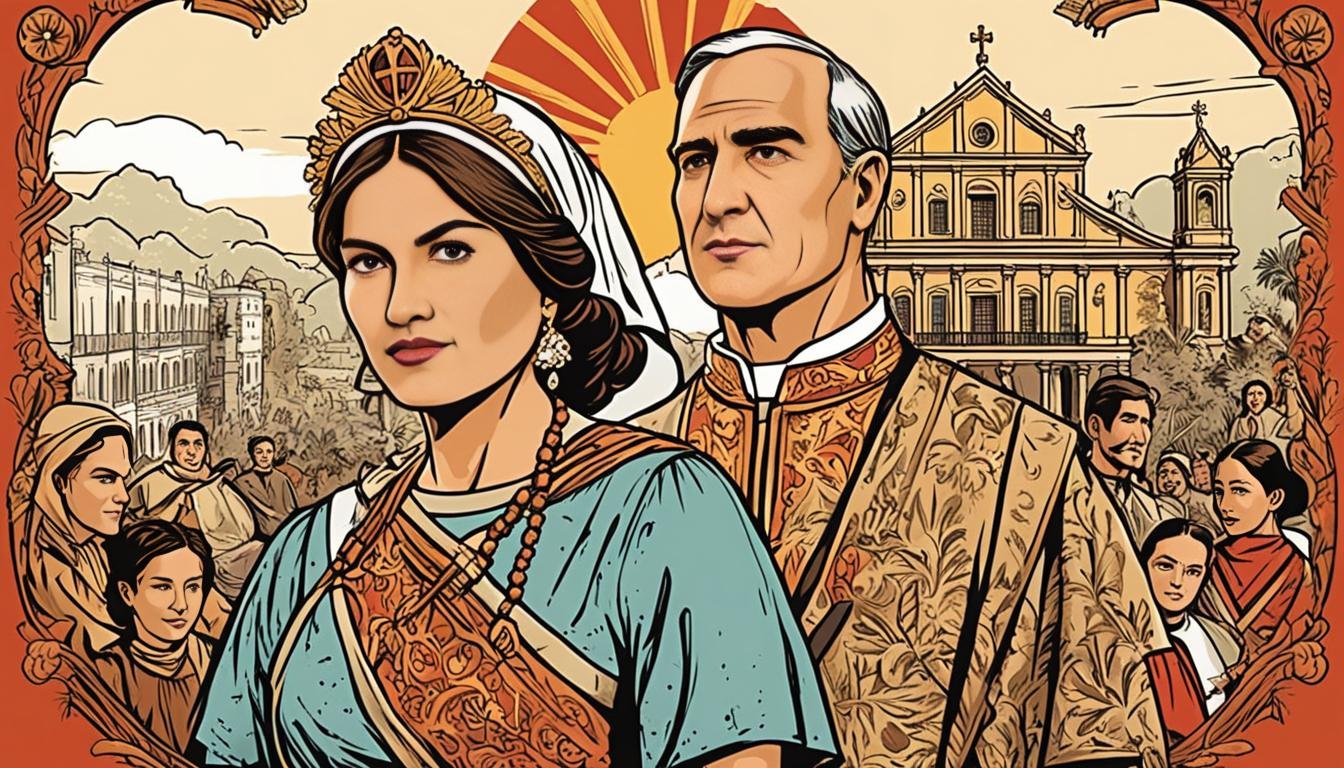The Philippines is a mix of over 150 cultural, ethnic, and linguistic groups. Spanish colonization tried to bring these different stories under one rule for nearly 400 years1. This blending of local folklore and Spanish cultural impacts interests historians and fans. Stories from the Philippines show a fight against being erased by outsiders, from Spanish conquerors to church missionaries.
In the 1500s, local rituals were harshly punished, and valuable histories and artifacts were destroyed to spread a new belief1. In the south, Islam, which was there before the Spanish, clashed with their goals, leading to long wars1. Despite these battles, stories changed and grew, highlighted by José Rizal’s legacy, a hero who fought against colonial control1.
For a more in-depth look at this era, check out an overview of the colonial period in the Philippines. It shares a detailed story that keeps the history alive. It shows both the fight of the Filipino spirit and the foreign influence on its history.
Key Takeaways
- Understanding how over 150 unique cultural groups were affected by Spanish colonization.
- Recognizing the significance of myth in preserving indigenous Filipino folklore within the Colonial Philippines history.
- Appreciating the intricate historical interplay between Philippine creation myths and Spanish colonial influence.
- Acknowledging the endurance of indigenous beliefs and practices despite centuries of foreign suppression.
- Exploring the rich catalogue of resistance movements and symbolic heroes inspired by colonial struggles.
Unveiling the Prolific Myths of Colonial Philippines
Philippine history is a mix of myths and true events, like the bamboo story and Magellan’s journey. These stories help us understand life before the Spanish came. They show a society ready for big changes.
The Spanish arrived in Manila in 1571, changing everything for leaders Rajah Mura and Rajah Matanda. Life was about community, from cangan clothes to living together. But when the Spanish came, the locals resisted, led by Rajah Soliman’s brave stand.
The Tale of Bamboo and Origins: A Common Creation Myth
The bamboo myth is important in the Philippines. It talks about the first people coming from bamboo. It symbolizes unity, unlike the division brought by Spanish interest. This myth is a big part of the Filipino identity.
Magellan’s Legacy: More Myth than Reality?
Magellan’s story often hides the true nature of pre-colonial Philippines. The stories of that time show varied cultures living together. They united against the Spanish, inspired by the bamboo myth of being strong and united.
When the Spanish took over, they changed Manila’s history on June 24, 1571. The locals wore cangan clothes and jewelry, showing they were advanced. But the Spanish tried to hide this with their own culture.
Looking at these myths helps us see the true Philippine culture before the Spanish. It’s important to share these stories with respect. They remind us of the Philippines’ rich past.
Deciphering Myths from Indigenous Philippine Folk Religions
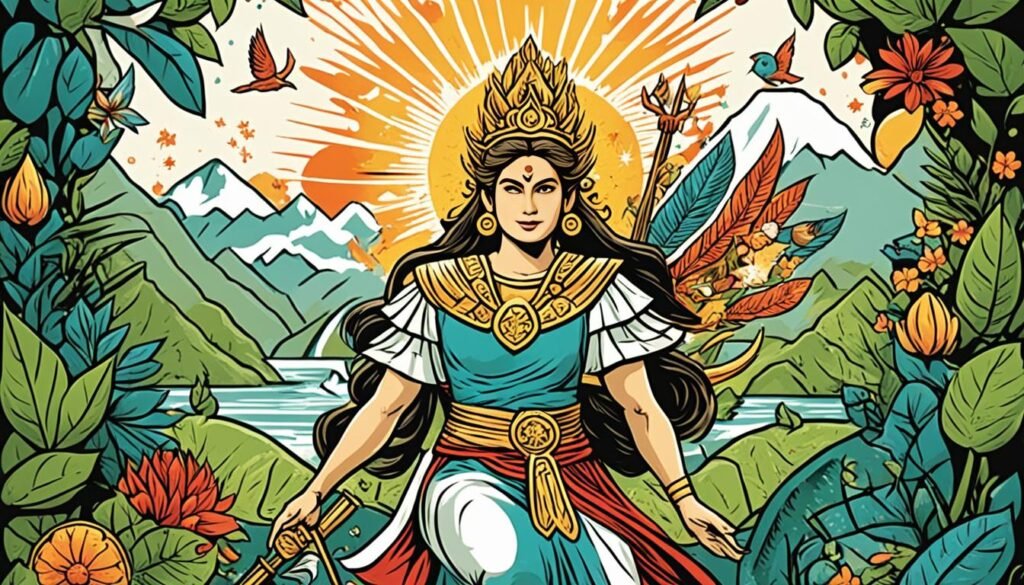
The Philippines is rich in indigenous beliefs and spiritual practices. These stem from the land’s ancient history. Regions have their own supernatural beings, leading to a collection of over 370 mythical creatures. The spiritual life of the Philippines intertwines with the first negrito tribes and later Austronesian migrants. These people added various supernatural beings to the mix.
Anito Worship and its Misinterpretations
Ancestor worship began between 15,000 to 7,000 years ago. It honors Anito spirits as guardians linked to nature. Colonial rulers often misinterpreted these beliefs, merging them with Catholic practices. This mix-up forced Filipinos to separate old meanings from colonial ones. Religious blending and cultural preservation shape how Filipinos view ancestor worship today.
The Blended Myths of Diwatas and Saints
The syncretization of Diwata deities with Catholic saints is a big part of Filipino spirit life. This blend allowed native beliefs to survive despite forced conversions. It’s a remarkable example of religious syncretism’s survival. To learn more about these traditions during colonial times, check out this article.
| Period | Belief Evolution | Evidence of Ancestral Worship |
|---|---|---|
| 15,000 – 7,000 years ago | Emergence of complex deities | Development of Anito worship |
| Arrival of Austronesians | Incorporation of new supernatural beings | Fusion of folk beliefs |
| Colonial Era | Syncretism with Catholicism | Diwatas re-imagined as saints |
Exploring these beliefs helps us understand the Filipino mind and culture. By knowing the history of these traditions, we respect the Philippines’ spiritual heritage. As we explore Philippine folk religions, we uncover stories of resilience. These stories show how Filipinos have maintained their spirituality throughout history.
Philippines Myths Influenced by Colonial Powers
Philippine mythology is rich, thanks to centuries of colonial influence on mythology. This shows how cultures mixing together can change stories and beliefs. The stories from the Philippines now include bits from different countries and cultures. This mix has created a myth evolution with a unique blend of ideas.
Trade was the first way foreign stories got to the Philippines. Indonesian tales mixed with Hindu stories around 200 to 300 CE. These stories created a base for many gods and universe tales3. Then, around 1300 CE, Islamic myths came, adding new stories, especially in the south32. When Spanish explorers came in the 16th century, they brought Christian stories. These added to the stories already there3.
In Luzon, Visayas, and Mindanao, you can find similar myths despite their different cultures. Stories like those of Bathala and Lumawig show this3. These similarities tell us about our shared desire to understand where we come from. They connect people from different times and places.
| Colonial Period | Influence on Mythology | Religious Impact |
|---|---|---|
| 200-300 CE | Introduction of Hindu mythologies through trade | Integration of Hindu deities and tales |
| 1300 CE | Spread of Islamic beliefs via traders | Islamic traditions influencing southern Philippines |
| Mid-16th Century | Spanish colonization and the introduction of Christian myths | Christian conversion and redefinition of indigenous worldview |
When the Spanish arrived, they united over 150 cultural groups. This even included a short time under British rule from 1762 to 1764. Some people fought against these changes, like the hero José Rizal1. The American takeover later brought more Christians, adding to the myth mix3.
This mix of myths from different rulers tells the story of a culture that keeps changing. It’s about how stories survive and blend, making Philippine mythology what it is now. This shows the strength of old stories and the impact of cultural interchange over time.
Legendary Creatures of Philippine Lore
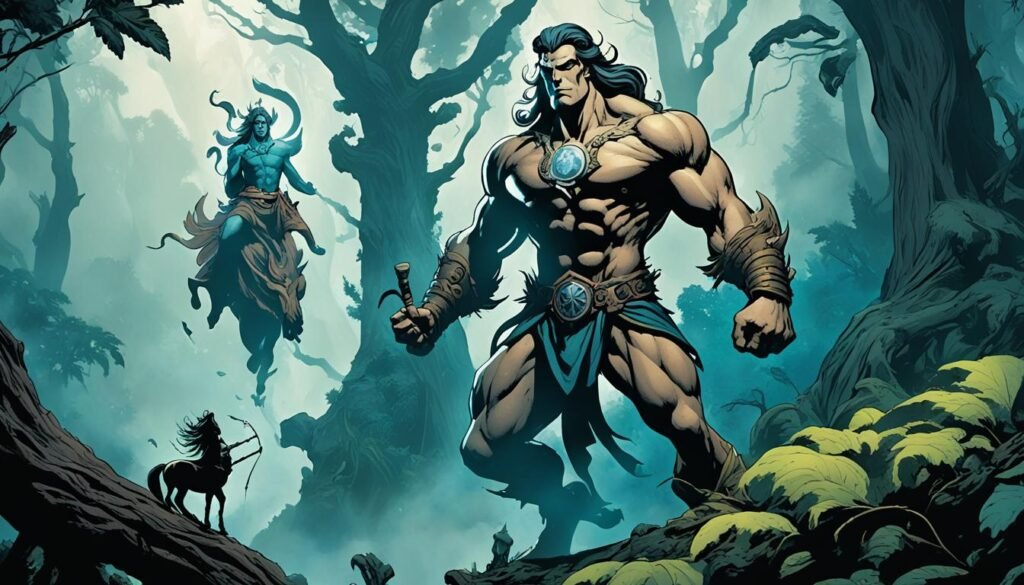
Philippine folklore is rich with tales of mysterious creatures. These stories are woven into the country’s history. When night falls, the Aswang myth brings fear, combining old beliefs and colonial tales4. These myths are not just scary stories but are part of Filipino culture, offering deep lessons and thrilling tales.
Tales of Aswang: Visceral Horror in Philippine Culture
The Aswang is the most feared creature in Filipino tales5. Its frightening image has grown over time, thanks to stories passed down through generations5. Spanish colonists used Aswangs to scare people, turning ancient gods into monsters4. Aswangs can change shape and even mimic people you know, filling hearts with dread5. This myth reflects the control and fear experienced during colonial times.
Kapres and Duendes: Interwoven in Filipino Childhood
Kapres and Duendes, unlike Aswangs, belong to a world of mysteries and moral tales within Kapre tales and Duende folklore. They are more than just spooky; they teach important lessons and hold cultural significance. Kapres, the giant guardians of the forests, and crafty Duendes live in the wild, respected and feared. Filipino children grow up with these stories, learning about their country’s magical forests and cherished myths.
Authors like Nathalie De Los Santos and IJP Ruiz are bringing these stories back to life4. Their books highlight powerful women and leaders from before the colonists arrived. They also show how colonialism has shaped Filipino culture. These myths have survived attempts to erase them, proving they are a vital part of the Philippines.
Filipino supernatural creatures, such as the Aswang, Kapre, and Duende, are key to the nation’s rich lore6. They show the complex history, culture, and identity of the Philippines. Despite their spooky appearances or the scary stories told about them, they fascinate and teach important lessons.
Tracing the Origins of the Infamous Juan Tamad
The Juan Tamad archetype, known for symbolizing extreme laziness, is rooted in Philippine folklore. It shows how cultural tales can teach us about work and responsibility. These stories provide a look into the importance of being diligent and responsible.
Juan Pusong, also known as Juan Tamad, is famous not just for being lazy but also smart in his stories7. Through laziness in Philippine myths, we learn moral values, especially important for young people. These tales are not only for fun but also share deep lessons.
Philippine folklore is rich with trickster characters, each reflecting unique societal values. Tricksters like Loki from Norse mythology and Hermes from Greek mythology share these clever traits7. These stories are full of humor and cleverness.
The role of Juan Tamad and similar characters helps us understand Philippine culture better. Across different regions, trickster tales discuss pride, foolishness, and mischief, all part of the term “Pusong”7. These narratives paint a picture of the diverse yet united Filipino identity and history7.
| Trickster Archetype | Regional Counterpart | Notable Tale | Character Traits |
|---|---|---|---|
| Juan Pusong (Tamad) | N/A | Crafty Laziness | Proud, Indolent |
| Pilandok (Mouse-Deer) | Muslim | Resourceful Wit | Intelligent, Resourceful |
| Guatchinango | Ilokano | Magical Deception | Pretentious, Mischievous |
| Turtle and Monkey | N/A | Wit over Smarts | Resourceful, Clever |
In the colorful world of Philippine myths, the story of the Turtle beating the Monkey teaches us that wisdom wins over mere smarts. The Guatchinango uses tricks to fool important figures, showing the trickster’s power against authority7. Pilandok stories reflect the same clever traits in Muslim culture, showing the wide reach of these tales7.
To understand the Juan Tamad archetype’s influence on Filipino culture, we need to explore its stories and meanings. The evolution of this character reveals much about the Philippine spirit and storytelling tradition. It keeps teaching us life lessons while evolving and staying relevant7.
Mythological Heroes of Pre-Colonial Philippines
The stories of pre-colonial Philippines are filled with legendary heroes. These characters show courage and wisdom. They help keep the nation’s stories alive. These heroes are the foundation of Filipino identity, passed down through many generations.

Bernardo Carpio: The Giant of Philippine Mythology
In Filipino stories, Bernardo Carpio stands tall. He fights for freedom and justice, trapped between two huge rocks. His tale, from the Montalban mountains, is a symbol of the fight for independence. It’s like a story about trying to break free from being controlled8.
Lumawig: The Great Spirit of Igorot Tribes
The Lumawig story comes from the Igorot highlands. It celebrates Lumawig, the Great Spirit who taught the people important things. From farming to laws, his wisdom helped shape their culture. Lumawig’s teachings inspired bravery and wisdom in the community8.
Philippine myths also have powerful women like Urduja, a royal warrior princess. She led Kinalakian, a group of fierce female warriors. This challenged traditional roles for women8. Lam-Ang, with his gift of speech from birth, is a strong figure in Ilocano legends8.
Stories of heroes like Baltog, Handyong, and Bantong are told in the Ibalon Epic. They fought mythical beasts—a gigantic boar, a changing enemy, and a huge cyclops. These stories are full of heroism and adventure8. The Hinilawod tales add more, with heroes like Aliguyon and siblings Labaw Donggon, Humadapnon, and Dumalapdap. They teach lessons of courage and right values through their epic journeys8.
The Myth of the Idyllic Paradise Lost to Colonialism
The concept of a Lost paradise archetype is key in Philippine culture. It shows a yearning for a Pre-colonial idyll free of conquest9. Writers often look back to a simple, untouched past. Yet, envisioning a perfect world is hard9. Many stories by Filipino authors turn today’s problems, like bad governance, into dark futures instead of perfect places9.
Looking back at good old days comes from the Philippines’ unique history. This preference for the past over the future is notable9. Early Filipino culture had a view of a universe with both heavenly and hellish realms9. But colonialism changed these ideas with a single view of paradise, like the Garden of Eden9.
Today’s Philippine fiction sees colonial impacts through a lens of deep nostalgia. Modern stories often picture tomorrow as grim versions of today’s issues9. In Metro Manila, some might think life in “The Hunger Games” is better than their own. This shows the deep social comments in these stories9.
| Exhibition | Theme | Date |
|---|---|---|
| “Tumba-Tumba: Stories & Spaces” | Childlike wonder and spaces | June 11 – July 30, 202110 |
| “Proto/Para: Rethinking Curatorial Work” | Innovation in curation | Feb 19 – Apr 09, 202110 |
| “Aligning Histories” | Historical narratives and art | Sep 14 – Oct 15, 201910 |
Art exhibitions continually explore identity and history. They pit the dream of a perfect future against the need to look back at a pre-colonial past10. Art helps us understand and reconnect with the Lost paradise archetype. It also builds our collective idea of a utopia amidst the charm of a Pre-colonial idyll that fascinates Filipinos10.
Christianity’s Role in Reshaping Philippine Myths
When Spanish Christian teachings met Philippine pre-colonial culture, it started a big change. This merging of beliefs changed local myths, leading to a mix of pagan and Christian traditions in today’s fiestas11. In just twenty-five years, half of the archipelago’s population turned to Christianity11. This shows how deeply Christian ideas influenced local myths and customs.
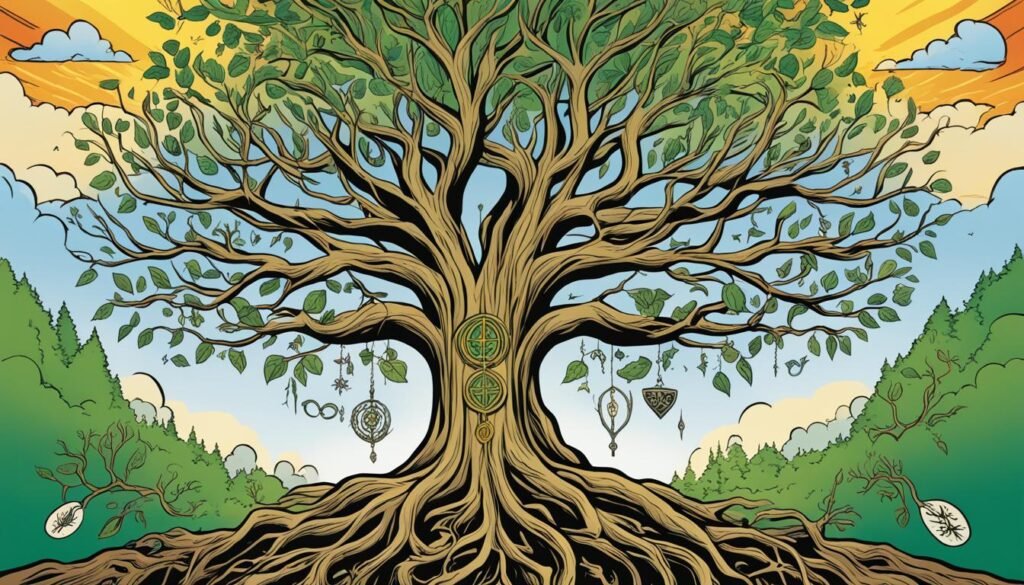
Now, 90% of Filipinos, out of 104 million, are Christians, mostly Catholics11. This huge change shows the lasting effect of Christian stories on Filipino culture. The spread of Christianity was helped by texts like the Doctrina Christiana, printed in 159311. It was one of the first books in the region, in both Tagalog and Spanish.
Syncretism: From Anito to Catholic Saints
Grammar books published from the 1600s to 1800s helped teach Christianity effectively11. They helped mix indigenous tales with Christian beliefs, creating a unique blend in the Philippines.
Rituals and Fiestas: A Fusion of Pagan and Christian Practices
Fiesta rituals beautifully mix Christian and local beliefs. This creates unique celebrations that show the cultural history and flexible spirit of Filipino faith over time.
Jose Rizal helped add depth to this mix of beliefs11. As a national hero, he showed problems within the church and Spanish rule. His death in 1896 pushed for independence, linking religion with politics in Filipino myths.
Catholicism in the Philippines during the Spanish colonial period
has shaped the nation’s identity. Its influence lives on in modern cultural practices.
The Virgin of Antipolo and Her Pre-Colonial Roots
The Virgin of Antipolo is loved by many for her healing touch. She links back to Philippine mythology with a mix of cultures and beliefs3. This icon stands in a place where ancient people honored powerful goddesses. They looked up to these goddesses to understand the mysteries of the universe3. Through her, the old beliefs combine with the Catholic faith. This creates a special spiritual tradition that still thrives today3.
Anitism, an old belief system, stays strong despite foreign changes. It hasn’t been fully explored yet3. The Virgin relates to Maguayen, a goddess from Visayan folklore. This shows a lasting respect from ancient times to now3. Filipino spirituality weaves together stories of gods and heroes. Despite changes, these stories bring people together across the islands3.
Philippine mythology lets us see the world and life in meaningful ways. It’s a heritage kept alive through stories that have survived many changes.
Once, the spiritual world in Luzon was a blend of Hindu, Muslim, and local beliefs. Their tales, rich and varied, told of creation and floods3. Today, the Virgin of Antipolo symbolizes the lasting power of these ancient beliefs. She shows how deep and strong indigenous religious connections are in Filipino culture3.
Revolutionary Spirits: Myths Driving Nationalist Movements
The story of Philippine independence struggle is carried forward by tales of revolutionary heroes. These heroes became icons of the fight for freedom from colonizers. Their stories are central to the Philippines’ journey towards self-rule.
Leaders like Fr. John Schumacher played a key role in these movements. His book, “The Propaganda Movement” sheds light on the morals of the Philippine Revolution. When he became a Filipino citizen in 1976, it showed his deep commitment to the country12.
His research discussed how clergy were crucial in the nationalist and revolutionary efforts. The details are in “Revolutionary Clergy.”12 The book points to a crucial separatist push after 1885. Leaders like Rizal and Luna were pivotal, influencing the rise of Filipino nationalism12.
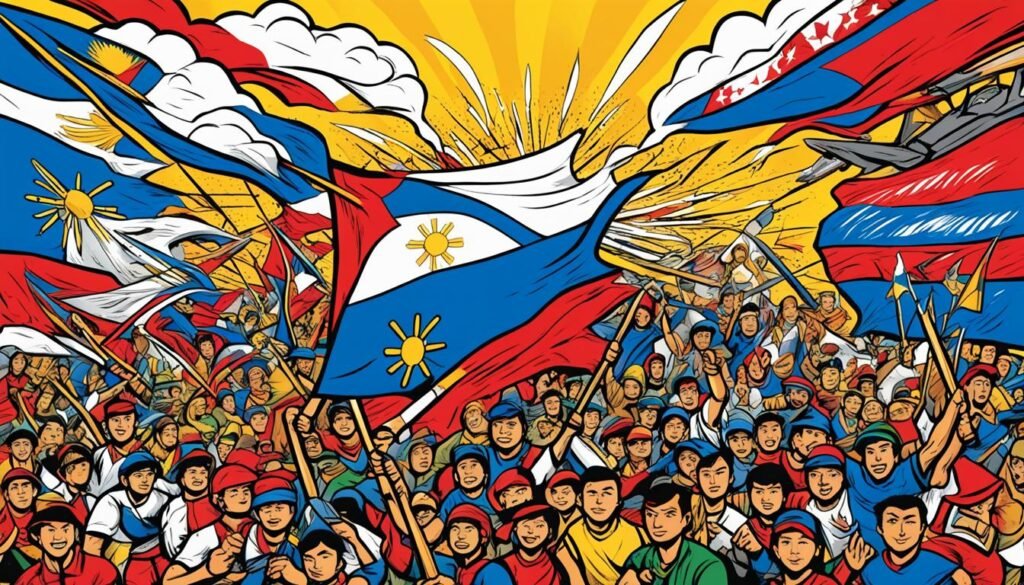
In 1995, a call from Father Jack sought a deeper look into “The Civil and Religious Ethic of Emilio Jacinto.”12 His analysis reveals the need for a secular national civic ethic. It also shows how Masonic ideas influenced the revolutionary movement12.
An email exchange shed light on the Masonic impact on the Propaganda Movement. This discussion revealed growing insights over time12. Father Jack’s further studies uncovered a changing view of the Katipunan’s goals, as noted in his Jacinto paper’s footnote No. 3012.
| Revolutionary Contribution | Impact |
|---|---|
| Propaganda Movement’s Clergy | Enabled a strong nationalist sentiment and organizational framework. |
| Filipino Clergy Citizenship | Bolstered the role of local leaders in the nationalist cause. |
| Secular National Civic Ethic | Laid the ground for a broad-based, inclusive independence struggle. |
The impact of these revolutionary heroes is still felt today, inspiring ongoing nationalism. Their legacy is a testament to the Philippines’ fight for, and achievement of, independence.
A Map of Myth: How Cartography Shaped Philippine Legends
The cartographic influence on Philippine culture and history is huge. Pedro Murillo Velarde’s 1734 map was precise in showing the archipelago. It also recorded mythical geography. This map is an early example of how historical maps can show a country’s identity. It blends geography with legendary tales.
Maps did a lot more than show physical space for Filipinos. They helped imagine a community tied together by legends and history. This cartography started the idea of a united nation. It added to the collective identity with every line drawn. Maps showed mountains, rivers, and seas, bringing gods and mythical heroes into reality.
Let’s look at how historical maps fixed local stories in place:
| Map Element | Mythical Association |
|---|---|
| Mountain Ranges | Abode of Deities and Epic Battles |
| Island Groups | Lost Kingdoms and Origins of Tribes |
| Seas and Bodies of Water | Monsters, Sea Serpents, and Underwater Realms |
The cartographic influence goes beyond just geography. It linked the fate and tales of people across the islands. This turned mythical geography into a part of every Filipino’s knowledge. Murillo Velarde’s map and others became a key part of our collective memory. They forever shaped the nation’s legends.
Today, these legends continue to inspire the Philippines. The mystery of cartography still captures the imagination. It shows not just where we are, but also who we are. These maps, especially the one from, still influence education, culture, and our ongoing story.
Philippine Mythology in the Modern Era
Philippine mythology has stood the test of time. It thrives in the heart of Filipino life today. Stories once told by word of mouth now spread through modern ways, like books and movies. This keeps the ancient legends alive and changing with our world.
Relevance of Myths in Contemporary Filipino Society
Today, Filipino writers are bringing back stories that colonizers tried to erase. These new stories often talk about today’s issues using old tales. For example, they discuss how women’s freedom was crushed before, showing how the past connects with now4. Works by Nathalie De Los Santos and IJP Ruiz help Filipinos reconnect with their roots. They fix the identity loss caused by centuries of foreign rule4.
Modern Media and the Perpetuation of Mythical Narratives
Shows and games have taken Filipino folklore worldwide. “Trese” has made these ancient tales popular on Netflix13. These stories do more than entertain; they share the rich culture of the Philippines with the world. From long-told legends13 to games like “Tadhana,” media plays a big role in keeping traditions alive13.
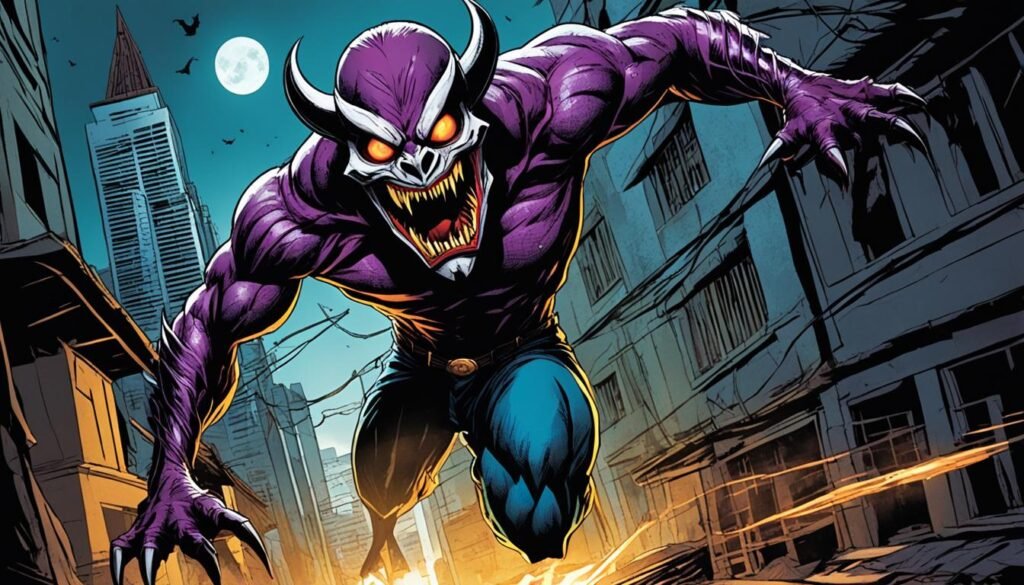
There are many ways people are exploring Filipino myths today. Through comics like “Myth Space” or games, these old stories speak to Filipinos in new ways13. This modern mythology is key to understanding who we are. It connects our past with today.
Philippine myths are becoming part of daily life again. This interest in old stories ties them to now, making them always relevant. It’s a way to honor and keep alive the wisdom of those who came before us.
| Media Outlet | Mythological Element | Cultural Impact |
|---|---|---|
| Netflix’s “Trese” | Philippine Deities | International broadcast of Filipino folklore narratives |
| Comic Book “Myth Space” | Mythical Creatures (Kapre, Tibalang) | Engagement with traditional lore through visual storytelling |
| RPG “Tadhana” | Mythical Figures (Tikbalang, Diwata) | Interactive experience that recontextualizes myths in gaming |
Retelling these stories lets us think about the tough history we’ve had. Media shows us the strength of Filipino women from before, like shamans4. This helps keep our traditions strong in our community today4.
The myths changing today are not just about keeping history alive. They’re a way for us to express ourselves and talk about what’s important to us. By bringing these old beliefs into our lives now, we make sure they stay a proud part of being Filipino.
Conclusion
In exploring Colonial Philippines history, we find a rich mix of myths. These stories show a strong cultural heritage that lives on in Filipino hearts14. Stories are grouped into tales, sayings, and songs. This helps us see the vast cultural wealth and the need to keep folklore alive14.
The Igorots’ respect for ancestors and the tales of creatures like the Aswang are woven into Philippine society14. Animism helped shape early beliefs, creating a rich tapestry of myths across different groups. These stories are vital to the Philippines’ folk traditions14.
In today’s fast-paced world, protecting our myths and folklore is crucial. Learning about animism’s role in shaping our past helps us appreciate our history14. These ancient tales are not just old stories. They are lively parts of our past that enrich our culture and its journey through time14.
FAQ
What are some myths from the colonial Philippines that are often mistaken for facts?
Common myths include Malakas and Maganda coming from bamboo. This tale is thought to show Filipino origins. Another is about Ferdinand Magellan, who they say peacefully colonized the Philippines. But these stories hide the real Philippine creation myths and the cultural effects of Spanish colonization.
How has Spanish colonization influenced indigenous Filipino folklore?
Spanish rule deeply changed indigenous Filipino folklore. It often led to native beliefs being misunderstood or pushed aside. The colonizers pushed for converting to Catholicism. This caused a mix of Anito worship with Catholic saints. It changed the heart of Philippine folk religions.
Can you explain the bamboo origin myth and its significance in the Philippines?
The bamboo myth tells how the first Filipino man and woman came from a bamboo. Named Malakas and Maganda, they symbolize the Filipino people’s start. This story shows their deep connection to their land.
Who are the Anito, and what role do they play in Filipino culture?
Anito are the spirits and nature gods in the local religions. They are key in the spiritual lives of many groups in the Philippines. Their worship shows the culture’s deep-rooted belief in animism. But, during Spanish rule, their importance was often misunderstood as Christianity was introduced.
What are Diwatas, and how have they been syncretized with Catholic Saints?
Diwatas are spirits or deities linked to nature in Philippine mythology. They were seen as environment guardians. Under Spanish rule, these indigenous deities were blended with Catholic saints. This made accepting the new religion easier for the locals. The unique blend of local and Christian beliefs came from this mixing.
How did colonial powers influence mythology in the Philippines?
Colonial powers added new aspects to Philippine myths through their influence. From Hindu and Islamic beliefs brought by traders to Christian ideas from the Spanish, these mixed with local tales. This created myths that evolved over time, showing the mark of colonial impact.
What is the legend of Juan Tamad, and how does it reflect Filipino values?
“Lazy John,” or Juan Tamad, is known for his extreme laziness. This tale warns against laziness, promoting hard work and effort. Juan Tamad is a cultural symbol, teaching the importance of being active through stories and fables.
Who are some of the mythological heroes in pre-colonial Philippines?
Before colonization, the Philippines had heroes like Bernardo Carpio and Lumawig. Carpio was a giant representing strength, while Lumawig was a Great Spirit revered by the Igorot, thought to have made humans and given them skills. These heroes showed the virtues of bravery and wisdom.
How has Christianity reshaped Philippine myths and rituals?
Christianity, via Spanish colonization, changed Philippine myths and rituals by introducing new figures and stories. Indigenous practices merged with Christian festivals, making a blend of old and new traditions. These mixed traditions show in today’s Filipino fiestas and cultural events.
In what ways do myths and legends continue to influence modern Filipino society?
Myths and legends still shape modern Filipino society. They’re seen in literature, arts, media, and traditions. They link to the country’s past and culture, teach moral lessons, and build national pride. Keeping these stories in modern media helps them stay relevant and appealing.
Source Links
- https://www.asianstudies.org/publications/eaa/archives/the-philippines-an-overview-of-the-colonial-era/
- https://www.aswangproject.com/tagalogs/
- https://en.wikipedia.org/wiki/Philippine_mythology
- https://www.cbc.ca/news/canada/british-columbia/b-c-authors-are-taking-back-the-monsters-of-filipino-folklore-from-colonial-influences-1.6077657
- https://www.academia.edu/37262886/Supernatural_Creatures_in_Philippine_Folklore
- https://artsandculture.google.com/story/5QUB0sPDcOoaLw
- https://www.aswangproject.com/philippine-tricksters/
- https://www.aswangproject.com/mythical-heroes-of-philippines/
- https://journals.ateneo.edu/index.php/apah/article/viewFile/2550/2468
- https://vargasmuseum.wordpress.com/
- https://blogs.loc.gov/international-collections/2018/07/catholicism-in-the-philippines-during-the-spanish-colonial-period-1521-1898/
- https://opinion.inquirer.net/74744/history-lessons-2
- https://www.gmanetwork.com/news/lifestyle/artandculture/687083/here-is-how-philippine-mythology-is-kept-alive-through-comics-games-and-anime/story/
- https://www.termpaperwarehouse.com/essay-on/Do-You-Believe-In-Philippine-Mythology/127789

